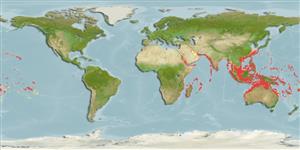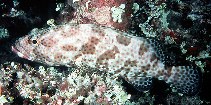Epinephelus tauvina (Fabricius, 1775)
Greasy grouper
Добавить Ваши наблюдения в Fish Watcher
| Native range | All suitable habitat | Point map | Year 2050 |

|
| This map was computer-generated and has not yet been reviewed. |
| Epinephelus tauvina AquaMaps Data sources: GBIF OBIS |
Загрузить свой Фото и Видео
Pictures | Videos | Stamps, coins, misc. | Изображение на GoogleEpinephelus tauvina
Picture by Randall, J.E.
Pictures | Videos | Stamps, coins, misc. | Изображение на GoogleEpinephelus tauvina
Picture by Randall, J.E.
Hong Kong country information
Common names:
Green grouper, 花英斑, 花頭梅
Occurrence: native
Salinity: marine
Abundance: | Ref:
Importance: | Ref:
Aquaculture: commercial | Ref: FAO Fishery Information, Data and Statistics Service, 1993
Regulations: | Ref:
Uses: live export: yes;
Comments: Reported from Mirs Bay, Tolo Channel, and Tolo Harbour (Ref. 126271). Cultured in floating cages and impoundments (Ref. 12089). Museum. CAS 62805. Also Ref. 5515.
National Checklist:
Country Information: https://www.cia.gov/library/publications/resources/the-world-factbook/geos/hk.html
National Fisheries Authority:
Occurrences: Occurrences Point map
Main Ref: Ni, I.-H. and K.-Y. Kwok, 1999
National Database:
Occurrence: native
Salinity: marine
Abundance: | Ref:
Importance: | Ref:
Aquaculture: commercial | Ref: FAO Fishery Information, Data and Statistics Service, 1993
Regulations: | Ref:
Uses: live export: yes;
Comments: Reported from Mirs Bay, Tolo Channel, and Tolo Harbour (Ref. 126271). Cultured in floating cages and impoundments (Ref. 12089). Museum. CAS 62805. Also Ref. 5515.
National Checklist:
Country Information: https://www.cia.gov/library/publications/resources/the-world-factbook/geos/hk.html
National Fisheries Authority:
Occurrences: Occurrences Point map
Main Ref: Ni, I.-H. and K.-Y. Kwok, 1999
National Database:
Common names from other countries
Классификация / Names народные названия | синонимы | Catalog of Fishes(род, виды) | ITIS | CoL | WoRMS | Cloffa
> Perciformes/Serranoidei (Groupers) > Epinephelidae (Groupers)
Etymology: Epinephelus: Greek, epinephelos = cloudy (Ref. 45335).
Etymology: Epinephelus: Greek, epinephelos = cloudy (Ref. 45335).
Environment: milieu / climate zone / depth range / distribution range экология
морской ассоциированный с рифами; мигрирует в океане (Ref. 51243); пределы глубины 1 - 300 m (Ref. 28016). Subtropical; 30°N - 32°S, 29°E - 123°W (Ref. 5222)
распространение страны | регионы FAO | Ecosystems | места находок | Point map | интродукции | Faunafri
Indo-Pacific: Red Sea to South Africa and eastward to Ducie in the Pitcairn Group, north to Japan, south to New South Wales and Lord Howe Island. Migration report from the eastern Mediterranean Sea (Ref. 6489, 5385) may be based on Epinephelus coioides specimens.
Length at first maturity / Size / Вес / Возраст
Maturity: Lm 61.1, range 61 - ? cm
Max length : 100.0 cm TL самец/пол неопределен; (Ref. 89972); common length : 90.0 cm TL самец/пол неопределен; (Ref. 5450)
Max length : 100.0 cm TL самец/пол неопределен; (Ref. 89972); common length : 90.0 cm TL самец/пол неопределен; (Ref. 5450)
Краткое описание определительные ключи | морфология | морфометрия
колючие лучи спинного плавника (общее число) : 11; членистые (мягкие) лучи спинного плавника (общее число) : 13 - 16; колючие лучи анального плавника: 3; членистые (мягкие) лучи анального плавника: 8. Color of head and body pale greenish grey or brown with round dark spots that vary from dull orange-red to dark brown, centers darker than the edges. A large black blotch (or group of black spots) often visible on body at the base of last 4 dorsal-fin spines. Five sub vertical dark bars may be present on body. Dark spots on soft dorsal, caudal and anal fins of juveniles are so close that the pale interspaces form a white reticulum. 95-112 scales in longitudinal series. Scales on body ctenoid in juveniles, becoming cycloid in adults except the area beneath and posterior to pectoral fins. Pyloric caeca 16-18. Further characterized by: elongate body, depth contained 3.0-3.6 times in SL; large head, length is 2.1-2.4 times in SL; snout length 2.0-2.4 times in upper-jaw length; interorbital area narrow, flat to slightly concave, interorbital width 6.8-8.1 times in HL and 3.1-4.0 times in upper jaw length; broadly rounded preopercle, serrae at angle of preopercle slightly enlarged; upper edge of operculum almost straight; posterior nostrils distinctly larger than anterior nostrils; maxilla reaching well past eye, greatest width about twice suborbital depth, maxilla width 6.8-8.1% of standard length; upper-jaw length 21-24% of SL; 2-5 rows of teeth on midlateral part of lower jaw; inner teeth at symphysis of upper jaw are longer than the fixed canines at front of jaw (Ref. 89707). Differs from E. howlandi by its more elongate body and closer-set spots (Ref. 37816).
Adults prefer clear water areas on coral reefs; juveniles have been taken from reef flats and in tide pools, adults found in deeper waters. Solitary and common in lightly fished areas (Ref. 37816). Adults from Oceania almost exclusively feed on fishes (holocentrids, mullid, and pomacentrid); and occasionally, crustaceans (Ref. 89707). Present in the Hong Kong live fish markets (Ref. 27253). Minimum depth reported taken from Ref. 30874. Occasionally ciguatoxic (Ref. 37816). Reports of sizes in excess of 80 cm total length for E. tauvina are probably based on misidentifications of E. coioides, E. malabaricus, and E. lanceolatus; these species grow much bigger than E. tauvina (Ref. 5222, Heemstra pers. comm. 09/04).
.
Life cycle and mating behavior половая зрелость | размножение | нерест | икра | Fecundity | личинки
Основная ссылка
Upload your references | ссылки | координатор | соавторы
Heemstra, P.C. and J.E. Randall, 1993. FAO Species Catalogue. Vol. 16. Groupers of the world (family Serranidae, subfamily Epinephelinae). An annotated and illustrated catalogue of the grouper, rockcod, hind, coral grouper and lyretail species known to date. Rome: FAO. FAO Fish. Synop. 125(16):382 p. (Ref. 5222)
Статус Красного Списка МСОП (Ref. 130435: Version 2024-1)
Нехватка данных (DD) ; Date assessed: 21 November 2016
Использование человеком
рыболовство: не имеет хозяйственного значения; аквакультура (рыбоводство): коммерческий; объект спортивного рыболовства: да
FAO(Aquaculture systems: production; рыболовство: production; publication : search) | FishSource | Sea Around Us
дополнительная информация
Population dynamics
Growth parameters
Max. ages / sizes
Length-weight rel.
Length-length rel.
Размерный состав
Mass conversion
пополнение
численность
Growth parameters
Max. ages / sizes
Length-weight rel.
Length-length rel.
Размерный состав
Mass conversion
пополнение
численность
Life cycle
размножение
половая зрелость
Fecundity
нерест
Spawning aggregations
икра
Развитие икры
личинки
динамика численности личинок
размножение
половая зрелость
Fecundity
нерест
Spawning aggregations
икра
Развитие икры
личинки
динамика численности личинок
Physiology
Body composition
Nutrients
Oxygen consumption
Swimming type
Swimming speed
Visual pigments
Fish sound
Diseases & Parasites
Toxicity (LC50s)
Body composition
Nutrients
Oxygen consumption
Swimming type
Swimming speed
Visual pigments
Fish sound
Diseases & Parasites
Toxicity (LC50s)
Human related
Aquaculture systems
особенности рыбоводства
степень растяжения
Ciguatera cases
Stamps, coins, misc.
Aquaculture systems
особенности рыбоводства
степень растяжения
Ciguatera cases
Stamps, coins, misc.
инструменты
Bio-Quiz | E-book | полевой определитель | определительные ключи | Длина-Частота | онтогенез | карта точек | Classification Tree
| Catch-MSY |
Специальные отчеты
Проверить содержание в аквариумах | Проверить опубликованные видовые данные | Проверить опубликованные данные по аквакультуре
Скачать в формате XML
ресурсы в Интернет
Alien/Invasive Species database | Aquatic Commons | BHL | Cloffa | BOLDSystems | Websites from users | Проверить FishWatcher | CISTI | Catalog of Fishes(род, виды) | DiscoverLife | DORIS | ECOTOX | Faunafri | Fishtrace | GenBank(Геном, Нуклеотид) | GloBI | GOBASE | | Google Books | Google Scholar | Google | IGFA World Record | MitoFish | национальные базы данных | Otolith Atlas of Taiwan Fishes | PubMed | Reef Life Survey | Scirus | SeaLifeBase | Tree of Life | Wikipedia(Вперёд, поиск) | World Records Freshwater Fishing | Zoological Record
Estimates based on models
Preferred temperature (Ref. 115969): 19.6 - 28.2, mean 26.2 (based on 1115 cells).
Phylogenetic diversity index (Ref. 82804): PD50 = 0.5000 [Uniqueness, from 0.5 = low to 2.0 = high].
Bayesian length-weight: a=0.01202 (0.01042 - 0.01387), b=3.04 (3.01 - 3.07), in cm Total Length, based on LWR estimates for this species (Ref. 93245).
Trophic level (Ref. 69278): 4.1 ±0.68 se; based on food items.
устойчивость к внешним воздействиям (Ref. 120179): низкий, минимальное время удвоения популяции 4.5-14 лет (K=0.1-0.17; tm=5-6; Fec = 354,989).
Fishing Vulnerability (Ref. 59153): High vulnerability (59 of 100).
Climate Vulnerability (Ref. 125649): Very high vulnerability (78 of 100).




